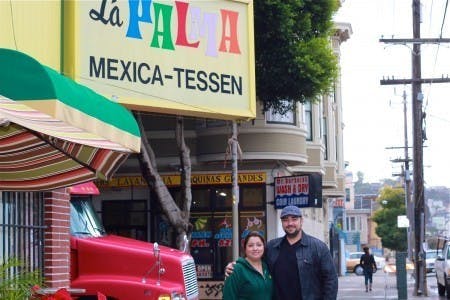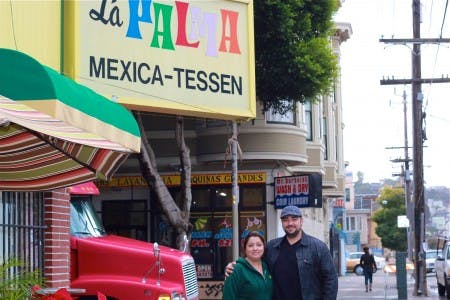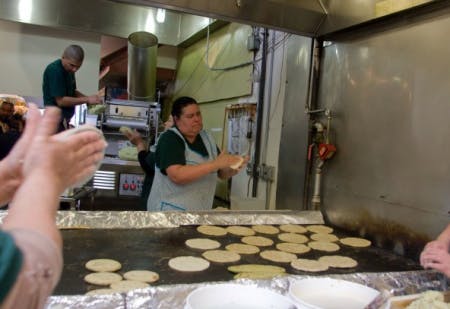If, as Joe says, the soul of a Mexican restaurant is found in its salsa, then its heart must be in its tortillas. Without a couple of well-made, fresh, chewy, warm, corn-fragrant tortillas keeping it all together, a taco would be one sad sack. Just some meat wrapped in an old, dry and cracky, flavorless puck of masa. What a buzzkill.
At Tacolicious, we get our tortillas daily from La Palma, the family-run and much loved Mexicatessen in the Mission that sells a lot more than tortillas (think everything from prepared foods to chilies, queso fresco, and more). What sounds quaint has actually developed into something of epic proportions. By the time our Palo Alto location opens in the beginning of February, La Palma will be making us about 125,000 tortillas a week, or a total of 6.5 million tortillas a year. That’s 492 miles of tortillas, which, if laid side by side, could pave a road from here to Mexicali. (Thank you Mike for that visual calculation.)
La Palma recently started working with Steve Sando and his company Rancho Gordo, our favorite source for heirloom beans. Together, they’re now producing tortillas made with heirloom corn. It’s a pretty cool collaboration.
Collaborating with local vendors like La Palma is a pleasure for us too. It lets us extend beyond our four walls and into the city at large. We develop friendships, not to mention get to support local businesses. Which is how we’ve gotten to know and love La Palma general manager Theresa Pasion, or Terry as we call her. She took a moment with Telmo the other day to talk shop.
Telmo: How long have you been here?
Terry: Twenty two years. I started off doing bookkeeping and filing.
Tell us about the history of La Palma.
The business started in 1953. In 1983, Paco and Ida became the owners. Paco used to come in here as a young boy. He always aspired to have this business. So the opportunity arose and so he purchased it. At the time, it was just selling handmade tortilla and carnitas. It was very small, nothing like it is now.
Where’s your family from?
I was born here in San Francisco. I live in the Outer Mission.
What makes a great tortilla?
Obviously, if we’re talking about a corn tortilla, it’s the corn. The cooking of the corn is the key to it. You don’t want to overcook it. Then there’s the grinding of the masa. At La Palma, we started out only selling hand-patted tortillas, so I prefer a handmade tortilla than a machine-made tortilla. Nice and hot.
What makes a tortilla to be ashamed of?
Maseca. It’s the powder you use when you can’t get corn, when you can’t get masa. And a lot of restaurants in the city do use it. It looks like pancake mix. You add water, lard, and salt.
What is the proper way to heat up a tortilla?
On a comal if you have one. But the way we did it when we were younger, we used to heat just on the open flame.
Do you ever heat it up with a little oil?
No! Plain.
[Editor’s note: Watch Telmo throw Joe under the bus of traditional Mexican cooking.]
Joe loves putting a little oil. He likes the outside a little crispy, like they do at La Taqueria.
Yeah, but you know what, we pride ourselves in making our tortillas fresh to order every day. We don’t need to do that. Even at home I don’t do that.
What’s your favorite way to cook with tortillas?
It’s the bad way—deep frying. Don’t put that! [laughs] Even though we make so many different things, it goes back to the basics—just getting the handmade tortilla with some Monterey Jack cheese and some chilies and melting it on the grill and no oil, nothing. Because the grease from the cheese and the handmade tortilla—oh man! That’s my favorite. It’s like a quesadilla.
How many local restaurants do you work with?
In the Bay Area, I would say we work with about 25 businesses. But I’m particular about who we do wholesale with because our tortillas don’t have any preservatives. They need to be used when they’re fresh. So if a restaurant is ordering 100 lbs and wants to make it last four days, I’m just really not going to do that. It’s going to bad and our name is on it.
What does it feel like to be here after all these years?
We have 35 people here and it feels like family. It’s not like going to a job, it’s like coming home.



